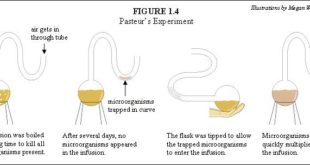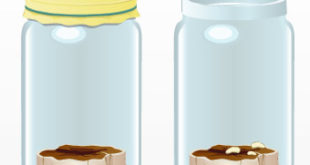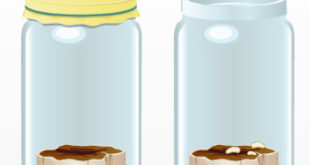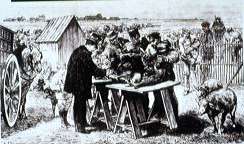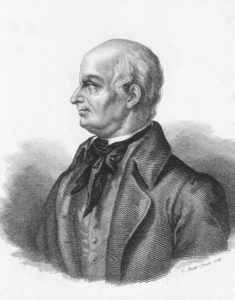
Louis Pasteur’s experiments fueled his scientific work and validating his ideas with careful experimention was his passion. The most famous Louis Pasteur experiment was that which he created to disprove the theory of Sponteneous Generation, the theory that living organisms can be “spontaneously generated” from non-living material. Through his experimentation Louis Pasteur concluded that microscopic organisms are present in the atmosphere. Therefore, any substance or material exposed to the air would be potentially subject to living processes. He created a special “swan neck flask” for this ground breaking experiment.
Purpose
To allow you to participate in some historically important issues in science, to conduct experiments, and to reason from the data while experiencing the limitations of the data in reaching valid conclusions.
Safety
- Wear safety goggles.
- Use caution when handling hot liquids.
Procedure
Seven 250 ml Erlenmeyer flasks will be set up according to the following conditions:
Flask 1 (Overall Control)
- Add 70 ml of clear broth to this flask. Do not cover.
Flask 2 (Spallanzani’s Control)
- 70 ml of clear broth to which has been added 10 ml of water.
- Boil gently for 15 minutes (about 10 ml of water should evaporate). Check the liquid level with the control flask and adjust, if necessary.
- LEAVE OPEN.
Flask 3 (Spallanzani’s Experiment)
- Add 10 ml of water to the 70 ml of clear broth.
- Boil gently for 15 minutes with a solid rubber stopper resting at an angle in the mouth of the flask (a loose plug).
- At the end of the boiling period, plug the flask with the rubber stopper.
- Seal with melted wax or paraffin.
Flask 4 (Pasteur’s Control)
- Heat the 70 ml of clear broth in a pressure cooker or autoclave for 15 minutes at 15 psi. LEAVE OPEN.
Flask 5 (Modified Pasteur’s Control)
- Flask with 70 ml of clear broth is plugged with a one-hole stopper into which has been inserted a straight glass tube (8-10 cm long, 7-8 mm diameter).
- Repeat the autoclaving procedure as listed for Flask #4.
- After autoclaving, seal the stopper to the neck of the flask as well as around the glass tube exiting the stopper, using melted wax or paraffin.
Flask 6 (Pasteur’s First Experiment)
- Add 70 ml of clear broth to the flask.
- Plug the flask with a one-hole stopper into which is inserted a J-shaped glass tube.
- Autoclave as done with Flasks #4 and #5.
- Seal stopper and glass tube as in Flask #5.
Flask 7 (Pasteur’s Final Experiment)
- Flask with 70 ml of clear broth is plugged with a one-hole stopper and an S-shaped glass tube.
- Autoclave the apparatus as in Flasks #4-#6. Seal as in Flask #5.
- Place all flasks in an area with reasonably constant temperature and away from sunlight and excessive heat.
Post-Laboratory Activity
- Look for changes in the flasks each day for 1 week (cloudiness is a sign of the presence of microorganisms; other changes include appearance of “scum” and mold). Record the day/date for each change.
- Continue observations weekly for 5 weeks.
- For flasks that have changed over 5 weeks, open the flasks and note any odors.
- For flasks that show no change, continue to observe indefinitely.
Data Analysis
- What happened in Flasks #2 and #3 (Spallanzani’s eperiment)? Were there any differences between the two flasks over the 5-week period?
- In Spallanzani’s experimentation, he found that no turbidity or foul odor developed in sealed Flask #3. His critics claimed that this did not refute the concept of spontaneous generation; it did not show that microbes had to get into the broth from the outside. How would these critics have to argue to defend their point of view in light of the evidence?
- For the work of Pasteur in Flasks #4-#7, what is the function of Flask #4?
- Why did Pasteur provide openings in his flasks? How does this relate to supporters of the idea of spontaneous generation and critics of Spallanzani?
- How do you explain the results obtained in Flask #7? Does this refute the concept of spontaneous generation? (See the introductory historical reading for this laboratory exercise.)
- Compare the results found in Flask #1 with those of Flasks #2 and #4. Are the results in agreement with what you would predict as a spontaneous generation believer? As a Pasteurian? Would the issue of spontaneous generation be resolved with these three setups?
 Pasteur Brewing Louis Pasteur – Science, Health, and Brewing
Pasteur Brewing Louis Pasteur – Science, Health, and Brewing 